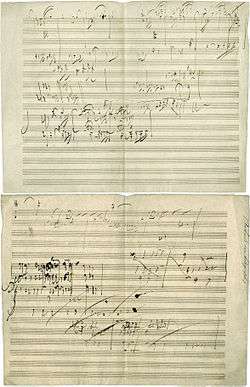Art music
Art music (alternatively called classical music, cultivated music, serious music, and canonic music)[1] is music considered to be of high aesthetic value.[2] It typically implies advanced structural and theoretical considerations[3] or a written musical tradition.[4] In this context, the terms "serious" or "cultivated" are frequently used to present a contrast with ordinary, everyday music (i.e. popular and folk music, also called "vernacular music").[2]
| Periods, eras, and movements of Western classical music | ||||||||||||||||||||
|---|---|---|---|---|---|---|---|---|---|---|---|---|---|---|---|---|---|---|---|---|
| Early period | ||||||||||||||||||||
|
||||||||||||||||||||
| Common practice period | ||||||||||||||||||||
|
||||||||||||||||||||
| Late 19th-century to 20th- and 21st-centuries | ||||||||||||||||||||
|
||||||||||||||||||||

Definition
"Art music" is mostly used to refer to music descending from the tradition of Western classical music. Authors associated with the critical musicology movement and popular music studies, such as Philip Tagg, tend to reject the elitism associated with art music; he refers to it as one of an "axiomatic triangle consisting of 'folk', 'art' and 'popular' musics".[5] He explains that each of these three is distinguishable from the others according to certain criteria.[5] According to Bruno Nettl, "Western classical music" may also be synonymous with "art music", "canonic music", "cultivated music", "serious music", as well as the more flippantly used "real music" and "normal music".[1] Musician Catherine Schmidt-Jones defines art music as "a music which requires significantly more work by the listener to fully appreciate than is typical of popular music". In her view, "[t]his can include the more challenging types of jazz and rock music, as well as Classical".[6]
The term "art music" refers primarily to classical traditions (including contemporary as well as historical classical music forms) that focus on formal styles, invite technical and detailed deconstruction[3] and criticism, and demand focused attention from the listener. In strict western practice, art music is considered primarily a written musical tradition,[4] preserved in some form of music notation, as opposed to being transmitted orally, by rote, or in recordings (like popular and traditional music).[4][7]
Popular music
There have been continual attempts throughout the history of popular music to make a claim for itself as art rather than as popular culture, and a number of music styles that were previously understood as "popular music" have since been categorized in the art or classical category.[8] According to the academic Tim Wall, the most significant example of the struggle between Tin Pan Alley, African-American, vernacular, and art discourses was in jazz. As early as the 1930s, artists attempted to cultivate ideas of "symphonic jazz", taking it away from its perceived vernacular and black American roots. Following these developments, histories of popular music tend to marginalize jazz, partly because the reformulation of jazz in the art discourse has been so successful that many (as of 2013) would not consider it a form of popular music.[8]
At the beginning of the 20th century, art music was divided into "serious music" and "light music".[9] During the second half of the century, there was a large-scale trend in American culture toward blurring the boundaries between art and pop music.[10] Beginning in 1966, the degree of social and artistic dialogue among rock musicians dramatically accelerated for bands who fused elements of composed music with the oral musical traditions of rock.[11] During the late 1960s and 1970s, progressive rock bands represented a form of crossover music that combined rock with high art musical forms either through quotation, allusion, or imitation.[10] Progressive music may be equated with explicit references to aspects of art music, sometimes resulting in the reification of rock as art music.[11]
While progressive rock is often cited for its merging of high culture and low culture, few artists incorporated literal classical themes in their work to any great degree, as author Kevin Holm-Hudson explains: "sometimes progressive rock fails to integrate classical sources ... [it] moves continuously between explicit and implicit references to genres and strategies derived not only from European art music, but other cultural domains (such as East Indian, Celtic, folk, and African) and hence involves a continuous aesthetic movement between formalism and eclecticism".[11]
See also
- Art song
- List of classical and art music traditions
- Music genre
- Progressive music
- Traditional music
References
- Bruno Nettl (1995). Heartland Excursions: Ethnomusicological Reflections on Schools of Music. University of Illinois Press. p. 3. ISBN 978-0-252-06468-5.
- Eisentraut, Jochen (2013). The Accessibility of Music: Participation, Reception, and Contact. Cambridge University Press. pp. 8, 196. ISBN 978-1-107-02483-0.
- Jacques Siron, "Musique Savante (Serious music)", Dictionnaire des mots de la musique (Paris: Outre Mesure): 242. ISBN 2-907891-22-7
- Denis Arnold, "Art Music, Art Song", in The New Oxford Companion to Music, Volume 1: A–J (Oxford and New York: Oxford University Press, 1983): 111. ISBN 0-19-311316-3
- Philip Tagg, "Analysing Popular Music: Theory, Method and Practice", Popular Music 2 (1982): 41.
- Schmidt-Jones, Catherine (10 January 2007). "What Kind of Music Is That?". Connexions. Retrieved 12 December 2008.
- Philip Tagg, "Analysing Popular Music: Theory, Method and Practice", Popular Music 2 (1982): 37–67, here 41–42.
- Tim Wall (2013). Studying Popular Music Culture. SAGE Publications. pp. 42–43. ISBN 978-1-4462-9101-6.
- Michal Smoira Cohn (2010). The Mission and Message of Music: Building Blocks to the Aesthetics of Music in our Time. Cambridge Scholars Publishing. pp. 93–94. ISBN 978-1-4438-1883-4.
- Jacqueline Edmondson, ed. (2013). Music in American Life: An Encyclopedia of the Songs, Styles, Stars, and Stories that Shaped our Culture. ABC-CLIO. pp. 317, 1233. ISBN 978-0-313-39348-8.
- Kevin Holm-Hudson, ed. (2013). Progressive Rock Reconsidered. Routledge. pp. 85–87. ISBN 978-1-135-71022-4.
Further reading
- Rockwell, John (26 June 1983). "Popular Music Takes a Serious Turn". The New York Times.
External links
